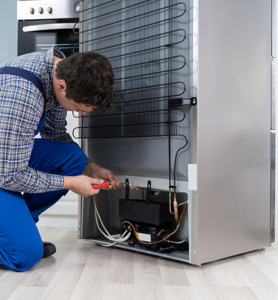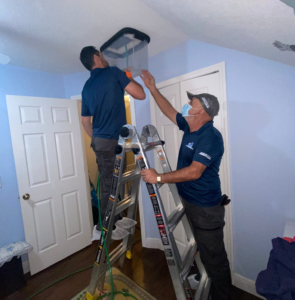Today, most households in developed nations have a refrigerator that they plug in and use. Refrigeration has had a major impact on world food production, consumption and safety.
Refrigerators work by causing the refrigerant circulating inside them to change from liquid to gas and absorb heat, cooling the space. It then passes through an expansion valve which reduces its pressure and temperature, before returning to the compressor. Click the https://alltemprefrigerationfl.com/ to learn more.

The middle shelves are the coldest areas in your refrigerator, so food stored there will stay fresher longer. Dairy products like milk, cheese, sour cream and yogurt should go on these shelves. Avoid storing foods with high water content, such as certain fruits and vegetables, here however, because the extra chilly temperatures may cause them to freeze and spoil.
Restaurant professionals advise keeping deli cooked meats, ready-to-eat sandwiches and salads on the top shelf so they are farthest away from raw foods that can spoil or make you sick. You can also store things like dips and leftover pizza on the upper shelf if they are in sealed containers.
Eggs should be kept in the refrigerator’s middle shelf as well, especially if they are still in their original cartons. The temperature in this area is more consistent and will extend the lifespan of your eggs.
The lower level of the refrigerator is even colder than the middle shelves and should be reserved for storing meats, chicken and fish. This will extend their freshness and reduce the risk of leaking raw meat juices on other foods that may not be cooked or seasoned.
Americans waste large amounts of food every day and one way this could be avoided is by simply storing foods in the correct place in your fridge. By following these tips, you can save money by avoiding food loss and keeping your kitchen running smoothly.
Many refrigerators are equipped with adjustable shelves that allow you to customize the storage of your food. Store foods of similar types together to make it easier for you to find what you are looking for and limit the amount of time your fridge is open, saving energy. Refrigerator shelving is available at your local wholesaler or online, and can be easily installed by extending the front of the shelf out to its full extension, then pushing it into the rear drawer guide and adjusting it to the desired position.
The Upper Shelves
The top shelf is ideal for foods that won’t need to be cooked or reheated. This includes dairy like yogurt and cheese, pre-prepared meals, salads and deli meats. It’s important to keep these items away from raw food on the bottom shelves because they could drip down and contaminate them. Also, foods on the top shelf won’t be exposed to the coldest area of the fridge so they won’t spoil as quickly.
Restaurant professionals suggest storing fruits, vegetables and herbs on the upper shelves. This is because they tend to be more delicate and will spoil faster if kept on lower shelves. It’s a good idea to group these foods together by type of food or how often you use them. This will help make it easier to grab the ingredients you need for a smoothie or meal and it will also reduce the amount of time you have your refrigerator door open.
The upper shelves are the warmest part of the fridge so they’re best for foods that can survive a few temperature fluctuations. Condiments like ketchup, mustard and mayo as well as nonperishable drinks (like bottled water and soda) and salsas are great examples. They’re often high in preservatives so they can handle slight variations in temperature and will keep fresher for longer.
Berries are another perfect upper shelf item, but make sure to store them away from tomatoes and peppers as they emit ethylene gases that cause these produce items to spoil more quickly. Some fruits, like pears, also release ethylene gas and will spoil faster if they’re stored nearby. Some refrigerators offer vents on the shelves to change the environment for different types of foods so you can get the most out of your food and your fridge.
The Bottom Shelves
The bottom shelf, and especially the meat drawer, should be reserved for foods that require the highest cooking temperature, such as raw fish or poultry. These should be stored in their sealed containers and kept away from other food types. This prevents juices from these foods from dribbling onto produce or other foods, potentially causing foodborne illness.
The lower shelves are also the best spot to store foods that have been prepared or cooked, as well as deli meats. This prevents them from spoiling too quickly and also makes it easier to grab something on the go when you’re in a hurry.
Most refrigerators have adjustable and removable shelves, so if you find that the layout doesn’t work for you, feel free to make changes as needed. Just make sure that all your food is clearly labeled with dates so you can keep track of what’s going off and when.
One thing to note about fridge storage is that some foods, like pears and apples, give off ethylene gas, which can cause other fruits and vegetables to go bad faster if they’re placed near them. This is why you should never store pears and apples together in your refrigerator. It’s a good idea to separate them into different compartments or at least move the pears to the back of the fridge, behind the broccoli and lettuce.
Finally, the door shelves are perfect for storing condiments and drinks. This is because many of these foods contain preservatives that make them more resistant to temperature fluctuations. So, save ketchup, mustard, mayo and other condiments in this area of your fridge, along with nonperishable drinks such as orange juice and soda.
If you have a refrigerator with humidity-adjustable crisper drawers, such as the LG French-Door GEGNE25JSKSS Refrigerator, use them to your advantage by placing thin-skinned fruits and veggies in high humidity areas and thick-skinned items in low-humidity zones. This will help to extend their shelf lives and save you money in the long run! The more you learn about the varying climate conditions of each shelf or storage compartment, the better you’ll be able to stock your refrigerator with foods that will last longer and reduce your grocery bills.
The Door Shelves
A refrigerator door shelf sits within your fridge’s inner door, offering a convenient and easily accessible storage space for condiments, beverages and other non-produce foods. This area of your refrigerator tends to have slightly warmer temperatures, making it a good place for food items that are high in preservatives and less sensitive to temperature fluctuations—think salsas, ketchup, mustard, mayonnaise, pasteurized juices and pickles. It’s also the best spot for storing milk and other dairy products that you use often, though you should avoid storing it on the door and instead put it toward the back of your fridge (or in the deli drawer) to preserve its freshness longer.
Fridges come with various types of small storage compartments designed to optimize the refrigerator’s usable storage space. Understanding how to utilize these storage spaces efficiently will help you organize your refrigerator more effectively and make finding your frequently used food items a breeze.
The shelving in your refrigerator’s inner door is usually adjustable, giving you the option of creating small, medium and tall storage spots based on your needs. Many of these shelves feature dividers and compartments, which can be useful for organizing similar foods in one place. Depending on the model you have, your refrigerator’s door might even come with a special egg holder to keep eggs at an ideal temperature.
To adjust your fridge’s door shelves, simply lift the shelf up and out of its supports. Then, slide it forward or backward until you’ve reached the desired position. If you’re unable to find a suitable space for a particular item, you can store it in a separate refrigerator drawer. When it comes time to clean the drawers and shelves in your refrigerator, empty all of their contents, then wipe them down with a solution of mild dish soap and warm water. Be sure to scrub down the corners and edges, where grime tends to build up. Regular cleaning and decluttering will ensure that your fridge remains hygienic and efficient over time.

